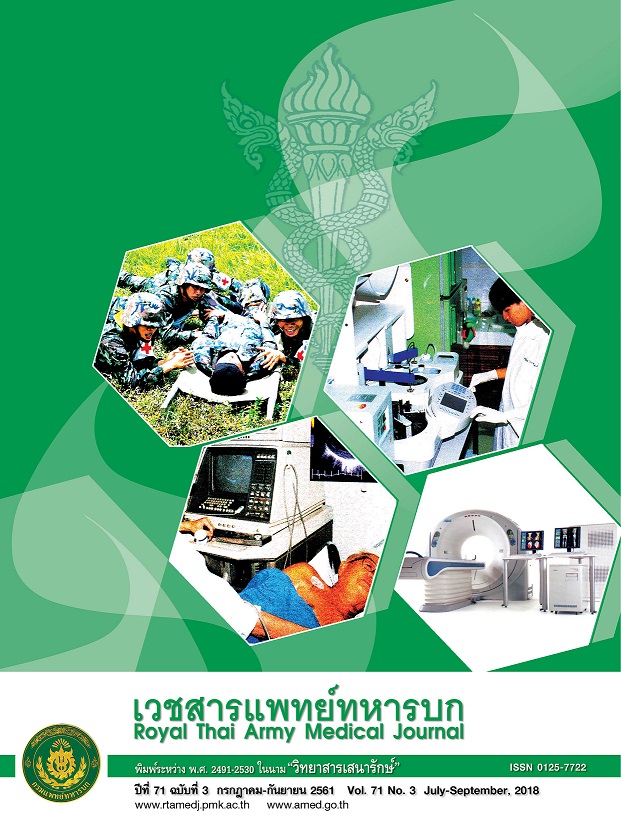สายรัดห้ามเลือดในสนามรบ
Main Article Content
Downloads
Download data is not yet available.
Article Details
รูปแบบการอ้างอิง
1.
วาสิกะสิน ว. สายรัดห้ามเลือดในสนามรบ. R. Thai Army Med. J. [อินเทอร์เน็ต]. 30 กันยายน 2018 [อ้างถึง 24 ธันวาคม 2025];71(3):203-6. available at: https://he02.tci-thaijo.org/index.php/rtamedj/article/view/148542
ประเภทบทความ
Subject Review
บทความในวารสารนี้อยู่ภายใต้ลิขสิทธิ์ของ กรมแพทย์ทหารบก และเผยแพร่ภายใต้สัญญาอนุญาต Creative Commons Attribution-NonCommercial-NoDerivatives 4.0 International (CC BY-NC-ND 4.0)
ท่านสามารถอ่านและใช้งานเพื่อวัตถุประสงค์ทางการศึกษา และทางวิชาการ เช่น การสอน การวิจัย หรือการอ้างอิง โดยต้องให้เครดิตอย่างเหมาะสมแก่ผู้เขียนและวารสาร
ห้ามใช้หรือแก้ไขบทความโดยไม่ได้รับอนุญาต
ข้อความที่ปรากฏในบทความเป็นความคิดเห็นของผู้เขียนเท่านั้น
ผู้เขียนเป็นผู้รับผิดชอบต่อเนื้อหาและความถูกต้องของบทความของตนอย่างเต็มที่
การนำบทความไปเผยแพร่ซ้ำในรูปแบบสาธารณะอื่นใด ต้องได้รับอนุญาตจากวารสาร
เอกสารอ้างอิง
Mabry RL, Holcomb JB, Baker AM, Cloonan CC, Uhorchak JM, Perkins DE, et al. United States Army Rangers in Somalia: an analysis of combat casualties on an urban battlefield. J Trauma. 2000;49:515-28; discussion 28-9.
Holcomb J, Caruso J, McMullin N, Wade CE, Pearse L, Oetjen-Gerdes L, et al. Causes of death in US Special Operations Forces in the global war on terrorism: 2001-2004. US Army Med Dep J. 2007:24-37.
Kelly JF, Ritenour AE, McLaughlin DF, Bagg KA, Apodaca AN, Mallak CT, et al. Injury severity and causes of death from Operation Iraqi Freedom and Operation Enduring Freedom: 2003-2004 versus 2006. J Trauma. 2008;64(2 Suppl):S21-6; discussion S6-7.
Mawhinney AC, Kirk SJ. A systematic review of the use of tourniquets and topical haemostatic agents in conflicts in Afghanistan and Iraq. J R Nav Med Serv. 2015;101:147-54.
Butler FK, Jr., Blackbourne LH. Battlefield trauma care then and now: a decade of Tactical Combat Casualty Care. J Trauma Acute Care Surg. 2012;73(6 Suppl 5):S395-402.
Butler FK. Two Decades of Saving Lives on the Battlefield: Tactical Combat Casualty Care Turns 20. Mil Med. 2017;182:e1563-e8.
Kragh JF, Jr., Walters TJ, Baer DG, Fox CJ, Wade CE, Salinas J, et al. Practical use of emergency tourniquets to stop bleeding in major limb trauma. J Trauma. 2008;64(2 Suppl):S38-49; discussion S-50.
Kragh JF, Jr., Walters TJ, Baer DG, Fox CJ, Wade CE, Salinas J, et al. Survival with emergency tourniquet use to stop bleeding in major limb trauma. Ann Surg. 2009;249:1-7.
Kauvar DS, Miller D, Walters TJ. Tourniquet use is not associated with limb loss following military lower extremity arterial trauma. J Trauma Acute Care Surg. 2018;85:495-9.
Kotwal RS, Butler FK, Gross KR, Kheirabadi BS, Baer DG, Dubick MA, et al. Management of Junctional Hemorrhage in Tactical Combat Casualty Care: TCCC Guidelines? Proposed Change 13-03. J Spec Oper Med. 2013;13:85-93.
Fletcher IR, Healy TE. The arterial tourniquet. Ann R Coll Surg Engl. 1983;65:409-17.
Wenke JC, Walters TJ, Greydanus DJ, Pusateri AE, Convertino VA. Physiological evaluation of the U.S. Army one-handed tourniquet. Mil Med. 2005;170:776-81.
Ruterbusch VL SM, Montgomery LD, Hopper KW, Gerth WA, ONR/MARCORSYSCOM. Evaluation of Self-Applied Tourniquets for Combat Applications. NEDU TR 05-15, Navy Experimental Diving Unit. 2005.
Wall PL, Duevel DC, Hassan MB, Welander JD, Sahr SM, Buising CM. Tourniquets and occlusion: the pressure of design. Mil Med. 2013;178:578-87.
Walters TJ, Wenke JC, Kauvar DS, McManus JG, Holcomb JB, Baer DG. Effectiveness of self-applied tourniquets in human volunteers. Prehosp Emerg Care. 2005;9:416-22.
Hill JP ML, Hopper KW, Roy LA. Evaluation of Self-Applied Tourniquets for Combat Applications, Second Phase. NEDU TR 07-07, Navy Experimental Diving Unit. 2007.
Kragh JF, Jr., Moore VK, 3rd, Aden JK, 3rd, Parsons DL, Dubick MA. Short Report Comparing Generation 6 Versus Prototype Generation 7 Combat Application Tourniquet(R) in a Manikin Hemorrhage Model. J Spec Oper Med. 2016;16:14-7.
Holcomb J, Caruso J, McMullin N, Wade CE, Pearse L, Oetjen-Gerdes L, et al. Causes of death in US Special Operations Forces in the global war on terrorism: 2001-2004. US Army Med Dep J. 2007:24-37.
Kelly JF, Ritenour AE, McLaughlin DF, Bagg KA, Apodaca AN, Mallak CT, et al. Injury severity and causes of death from Operation Iraqi Freedom and Operation Enduring Freedom: 2003-2004 versus 2006. J Trauma. 2008;64(2 Suppl):S21-6; discussion S6-7.
Mawhinney AC, Kirk SJ. A systematic review of the use of tourniquets and topical haemostatic agents in conflicts in Afghanistan and Iraq. J R Nav Med Serv. 2015;101:147-54.
Butler FK, Jr., Blackbourne LH. Battlefield trauma care then and now: a decade of Tactical Combat Casualty Care. J Trauma Acute Care Surg. 2012;73(6 Suppl 5):S395-402.
Butler FK. Two Decades of Saving Lives on the Battlefield: Tactical Combat Casualty Care Turns 20. Mil Med. 2017;182:e1563-e8.
Kragh JF, Jr., Walters TJ, Baer DG, Fox CJ, Wade CE, Salinas J, et al. Practical use of emergency tourniquets to stop bleeding in major limb trauma. J Trauma. 2008;64(2 Suppl):S38-49; discussion S-50.
Kragh JF, Jr., Walters TJ, Baer DG, Fox CJ, Wade CE, Salinas J, et al. Survival with emergency tourniquet use to stop bleeding in major limb trauma. Ann Surg. 2009;249:1-7.
Kauvar DS, Miller D, Walters TJ. Tourniquet use is not associated with limb loss following military lower extremity arterial trauma. J Trauma Acute Care Surg. 2018;85:495-9.
Kotwal RS, Butler FK, Gross KR, Kheirabadi BS, Baer DG, Dubick MA, et al. Management of Junctional Hemorrhage in Tactical Combat Casualty Care: TCCC Guidelines? Proposed Change 13-03. J Spec Oper Med. 2013;13:85-93.
Fletcher IR, Healy TE. The arterial tourniquet. Ann R Coll Surg Engl. 1983;65:409-17.
Wenke JC, Walters TJ, Greydanus DJ, Pusateri AE, Convertino VA. Physiological evaluation of the U.S. Army one-handed tourniquet. Mil Med. 2005;170:776-81.
Ruterbusch VL SM, Montgomery LD, Hopper KW, Gerth WA, ONR/MARCORSYSCOM. Evaluation of Self-Applied Tourniquets for Combat Applications. NEDU TR 05-15, Navy Experimental Diving Unit. 2005.
Wall PL, Duevel DC, Hassan MB, Welander JD, Sahr SM, Buising CM. Tourniquets and occlusion: the pressure of design. Mil Med. 2013;178:578-87.
Walters TJ, Wenke JC, Kauvar DS, McManus JG, Holcomb JB, Baer DG. Effectiveness of self-applied tourniquets in human volunteers. Prehosp Emerg Care. 2005;9:416-22.
Hill JP ML, Hopper KW, Roy LA. Evaluation of Self-Applied Tourniquets for Combat Applications, Second Phase. NEDU TR 07-07, Navy Experimental Diving Unit. 2007.
Kragh JF, Jr., Moore VK, 3rd, Aden JK, 3rd, Parsons DL, Dubick MA. Short Report Comparing Generation 6 Versus Prototype Generation 7 Combat Application Tourniquet(R) in a Manikin Hemorrhage Model. J Spec Oper Med. 2016;16:14-7.


